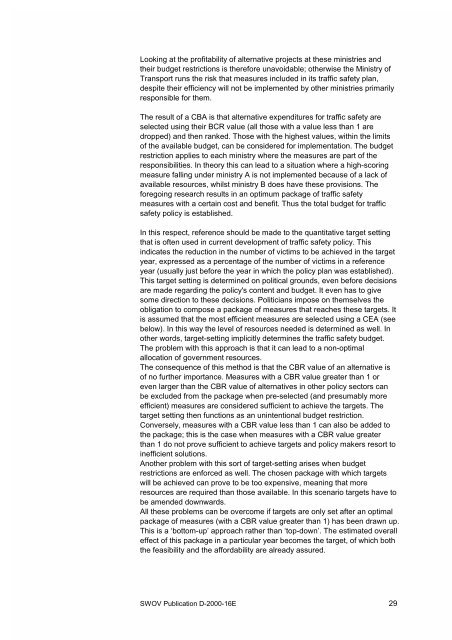Economic evaluation of road safety measures - Swov
Economic evaluation of road safety measures - Swov
Economic evaluation of road safety measures - Swov
You also want an ePaper? Increase the reach of your titles
YUMPU automatically turns print PDFs into web optimized ePapers that Google loves.
Looking at the pr<strong>of</strong>itability <strong>of</strong> alternative projects at these ministries and<br />
their budget restrictions is therefore unavoidable; otherwise the Ministry <strong>of</strong><br />
Transport runs the risk that <strong>measures</strong> included in its traffic <strong>safety</strong> plan,<br />
despite their efficiency will not be implemented by other ministries primarily<br />
responsible for them.<br />
The result <strong>of</strong> a CBA is that alternative expenditures for traffic <strong>safety</strong> are<br />
selected using their BCR value (all those with a value less than 1 are<br />
dropped) and then ranked. Those with the highest values, within the limits<br />
<strong>of</strong> the available budget, can be considered for implementation. The budget<br />
restriction applies to each ministry where the <strong>measures</strong> are part <strong>of</strong> the<br />
responsibilities. In theory this can lead to a situation where a high-scoring<br />
measure falling under ministry A is not implemented because <strong>of</strong> a lack <strong>of</strong><br />
available resources, whilst ministry B does have these provisions. The<br />
foregoing research results in an optimum package <strong>of</strong> traffic <strong>safety</strong><br />
<strong>measures</strong> with a certain cost and benefit. Thus the total budget for traffic<br />
<strong>safety</strong> policy is established.<br />
In this respect, reference should be made to the quantitative target setting<br />
that is <strong>of</strong>ten used in current development <strong>of</strong> traffic <strong>safety</strong> policy. This<br />
indicates the reduction in the number <strong>of</strong> victims to be achieved in the target<br />
year, expressed as a percentage <strong>of</strong> the number <strong>of</strong> victims in a reference<br />
year (usually just before the year in which the policy plan was established).<br />
This target setting is determined on political grounds, even before decisions<br />
are made regarding the policy's content and budget. It even has to give<br />
some direction to these decisions. Politicians impose on themselves the<br />
obligation to compose a package <strong>of</strong> <strong>measures</strong> that reaches these targets. It<br />
is assumed that the most efficient <strong>measures</strong> are selected using a CEA (see<br />
below). In this way the level <strong>of</strong> resources needed is determined as well. In<br />
other words, target-setting implicitly determines the traffic <strong>safety</strong> budget.<br />
The problem with this approach is that it can lead to a non-optimal<br />
allocation <strong>of</strong> government resources.<br />
The consequence <strong>of</strong> this method is that the CBR value <strong>of</strong> an alternative is<br />
<strong>of</strong> no further importance. Measures with a CBR value greater than 1 or<br />
even larger than the CBR value <strong>of</strong> alternatives in other policy sectors can<br />
be excluded from the package when pre-selected (and presumably more<br />
efficient) <strong>measures</strong> are considered sufficient to achieve the targets. The<br />
target setting then functions as an unintentional budget restriction.<br />
Conversely, <strong>measures</strong> with a CBR value less than 1 can also be added to<br />
the package; this is the case when <strong>measures</strong> with a CBR value greater<br />
than 1 do not prove sufficient to achieve targets and policy makers resort to<br />
inefficient solutions.<br />
Another problem with this sort <strong>of</strong> target-setting arises when budget<br />
restrictions are enforced as well. The chosen package with which targets<br />
will be achieved can prove to be too expensive, meaning that more<br />
resources are required than those available. In this scenario targets have to<br />
be amended downwards.<br />
All these problems can be overcome if targets are only set after an optimal<br />
package <strong>of</strong> <strong>measures</strong> (with a CBR value greater than 1) has been drawn up.<br />
This is a ‘bottom-up’ approach rather than ‘top-down’. The estimated overall<br />
effect <strong>of</strong> this package in a particular year becomes the target, <strong>of</strong> which both<br />
the feasibility and the affordability are already assured.<br />
SWOV Publication D-2000-16E 29
















